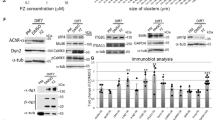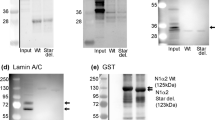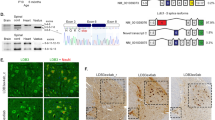Abstract
Muscular dystrophies are among the most common human genetic diseases and are characterized by progressive muscle degeneration. Muscular dystrophies result from genetic defects in components of the dystrophin–glycoprotein complex (DGC), a multimeric complex found in the muscle cell plasma membrane1. The DGC links the intracellular cytoskeleton to the extracellular matrix and is thought to be important for maintaining the mechanical integrity of muscles2 and organizing signalling molecules3. The exact role of the DGC in the pathogenesis of disease has, however, remained uncertain4. Mutations in Caenorhabditis elegans DGC genes lead to specific defects in coordinated movement and can also cause muscle degeneration5,6,7. Here we show that mutations in the gene snf-6 result in phenotypes indistinguishable from those of the DGC mutants, and that snf-6 encodes a novel acetylcholine/choline transporter. SNF-6 mediates the uptake of acetylcholine at neuromuscular junctions during periods of increased synaptic activity. SNF-6 also interacts with the DGC, and mutations in DGC genes cause a loss of SNF-6 at neuromuscular junctions. Improper clearing of acetylcholine and prolonged excitation of muscles might contribute to the pathogenesis of muscular dystrophies.
This is a preview of subscription content, access via your institution
Access options
Subscribe to this journal
Receive 51 print issues and online access
$199.00 per year
only $3.90 per issue
Buy this article
- Purchase on Springer Link
- Instant access to full article PDF
Prices may be subject to local taxes which are calculated during checkout





Similar content being viewed by others
References
Durbeej, M. & Campbell, K. P. Muscular dystrophies involving the dystrophin–glycoprotein complex: an overview of current mouse models. Curr. Opin. Genet. Dev. 12, 349–361 (2002)
McArdle, A., Edwards, R. H. & Jackson, M. J. Time course of changes in plasma membrane permeability in the dystrophin-deficient mdx mouse. Muscle Nerve 17, 1378–1384 (1994)
Grady, R. M. et al. Maturation and maintenance of the neuromuscular synapse: genetic evidence for roles of the dystrophin–glycoprotein complex. Neuron 25, 279–293 (2000)
Burton, E. A. & Davies, K. E. in Pathogenesis of Neurodegenerative Disorders (ed. Mattson, M. P.) 239–284 (Humana Press, Totowa, New Jersey, 2000)
Bessou, C., Giugia, J. B., Franks, C. J., Holden-Dye, L. & Segalat, L. Mutations in the Caenorhabditis elegans dystrophin-like gene dys-1 lead to hyperactivity and suggest a link with cholinergic transmission. Neurogenetics 2, 61–72 (1998)
Gieseler, K., Bessou, C. & Segalat, L. Dystrobrevin- and dystrophin-like mutants display similar phenotypes in the nematode Caenorhabditis elegans. Neurogenetics 2, 87–90 (1999)
Grisoni, K., Martin, E., Gieseler, K., Mariol, M. C. & Segalat, L. Genetic evidence for a dystrophin–glycoprotein complex (DGC) in Caenorhabditis elegans. Gene 294, 77–86 (2002)
Davies, A. G. et al. A central role of the BK Potassium channel in behavioral responses to ethanol in C. elegans. Cell 115, 655–666 (2003)
Shioi, G. et al. Mutations affecting nerve attachment of Caenorhabditis elegans. Genetics 157, 1611–1622 (2001)
Giugia, J., Gieseler, K., Arpagaus, M. & Segalat, L. Mutations in the dystrophin-like dys-1 gene of Caenorhabditis elegans result in reduced acetylcholinesterase activity. FEBS Lett. 463, 270–272 (1999)
Gieseler, K. et al. Molecular, genetic and physiological characterisation of dystrobrevin-like (dyb-1) mutants of Caenorhabditis elegans. J. Mol. Biol. 307, 107–117 (2001)
Froehner, S. C., Adams, M. E., Peters, M. F. & Gee, S. H. Syntrophins: modular adapter proteins at the neuromuscular junction and the sarcolemma. Soc. Gen. Physiol. Ser. 52, 197–207 (1997)
Gieseler, K., Abdel-Dayem, M. & Segalat, L. In vitro interactions of Caenorhabditis elegans dystrophin with dystrobrevin and syntrophin. FEBS Lett. 461, 59–62 (1999)
Megeney, L. A., Kablar, B., Garrett, K., Anderson, J. E. & Rudnicki, M. A. MyoD is required for myogenic stem cell function in adult skeletal muscle. Genes Dev. 10, 1173–1183 (1996)
Gieseler, K., Grisoni, K. & Segalat, L. Genetic suppression of phenotypes arising from mutations in dystrophin-related genes in Caenorhabditis elegans. Curr. Biol. 10, 1092–1097 (2000)
Mariol, M. C. & Segalat, L. Muscular degeneration in the absence of dystrophin is a calcium-dependent process. Curr. Biol. 11, 1691–1694 (2001)
Potter, L. T. Synthesis, storage and release of [14C]acetylcholine in isolated rat diaphragm muscles. J. Physiol. (Lond.) 206, 145–166 (1970)
Saelens, J. K. & Stoll, W. R. Radiochemical determination of choline and acetylcholine flux from isolated tissue. J. Pharmacol. Exp. Ther. 147, 336–342 (1965)
Salpeter, M. M., Kasprzak, H., Feng, H. & Fertuck, H. Endplates after esterase inactivation in vivo: correlation between esterase concentration, functional response and fine structure. J. Neurocytol. 8, 95–115 (1979)
Leonard, J. P. & Salpeter, M. M. Agonist-induced myopathy at the neuromuscular junction is mediated by calcium. J. Cell Biol. 82, 811–819 (1979)
Jackson, M. J., Jones, D. A. & Edwards, R. H. Measurements of calcium and other elements in muscle biopsy samples from patients with Duchenne muscular dystrophy. Clin. Chim. Acta 147, 215–221 (1985)
Kramarcy, N. R. & Sealock, R. Syntrophin isoforms at the neuromuscular junction: developmental time course and differential localization. Mol. Cell. Neurosci. 15, 262–274 (2000)
Webster, C., Silberstein, L., Hays, A. P. & Blau, H. M. Fast muscle fibers are preferentially affected in Duchenne muscular dystrophy. Cell 52, 503–513 (1988)
Karpati, G., Carpenter, S. & Prescott, S. Small-caliber skeletal muscle fibers do not suffer necrosis in mdx mouse dystrophy. Muscle Nerve 11, 795–803 (1988)
Brenner, S. The genetics of Caenorhabditis elegans. Genetics 77, 71–94 (1974)
Miyabayashi, T., Palfreyman, M. T., Sluder, A. E., Slack, F. & Sengupta, P. Expression and function of members of a divergent nuclear receptor family in Caenorhabditis elegans. Dev. Biol. 215, 314–331 (1999)
Richmond, J. E. & Jorgensen, E. M. One GABA and two acetylcholine receptors function at the C. elegans neuromuscular junction. Nature Neurosci. 2, 791–797 (1999)
Richmond, J. E., Davis, W. S. & Jorgensen, E. M. UNC-13 is required for synaptic vesicle fusion in C. elegans. Nature Neurosci. 2, 959–964 (1999)
Waterston, R. H., Hirsh, D. & Lane, T. R. Dominant mutations affecting muscle structure in Caenorhabditis elegans that map near the actin gene cluster. J. Mol. Biol. 180, 473–496 (1984)
Acknowledgements
We thank J. S. Kim, C. Yu and R. Ho for technical help, J. Rand and C. Bargmann for personal communication and helpful discussions, and all members of the McIntire laboratory for discussions and comments on the manuscript. Some strains were provided by the National Bioresource Project (Japan), the C. elegans Gene Knockout Consortium and the Caenorhabditis Genetics Center. This work was supported by funds provided by the State of California for medical research on alcohol and substance abuse through the University of California, San Francisco, by a grant to S.L.M. from the Department of the Army, by a grant to J.E.R. from NIH and by a development grant to H.K. from the Muscular Dystrophy Association.
Author information
Authors and Affiliations
Corresponding author
Ethics declarations
Competing interests
The authors declare that they have no competing financial interests.
Supplementary information
Supplementary Figure 1
Expression of STN-1 and SGN-1 in C. elegans muscle in the presence and absence of a snf-6 mutation (PDF 788 kb)
Supplementary Methods
Genetic Mapping, RNAi and Rescue. (DOC 19 kb)
Supplementary Table 1
Characterization of the locomotory behaviour of mutants. (DOC 25 kb)
Supplementary Notes
We did not observe any uptake of other compounds including a number of neurotransmitters. (DOC 19 kb)
Supplementary Video 1
This movie was taken immediately after animals were transferred to a new plate. Wild-type N2 animals. (MP4 371 kb)
Supplementary Video 2
This movie was taken immediately after animals were transferred to a new plate. dys-1 mutants. (MP4 378 kb)
Supplementary Video 3
This movie was taken immediately after animals were transferred to a new plate. snf-6 mutants. (MP4 372 kb)
Supplementary Video 4
This movie was taken immediately after animals were transferred to a new plate. snf-6; ace-1 mutants. (MP4 369 kb)
Supplementary Video 5
Wild-type N2 movie before and after touch. (MP4 709 kb)
Supplementary Video 6
snf-6 mutant movie before and after touch. (MP4 507 kb)
Rights and permissions
About this article
Cite this article
Kim, H., Rogers, M., Richmond, J. et al. SNF-6 is an acetylcholine transporter interacting with the dystrophin complex in Caenorhabditis elegans. Nature 430, 891–896 (2004). https://doi.org/10.1038/nature02798
Received:
Accepted:
Issue Date:
DOI: https://doi.org/10.1038/nature02798
This article is cited by
-
The Roles of the Dystrophin-Associated Glycoprotein Complex at the Synapse
Molecular Neurobiology (2010)
-
Dissecting muscle and neuronal disorders in a Drosophila model of muscular dystrophy
The EMBO Journal (2007)
-
Finding function in novel targets: C. elegans as a model organism
Nature Reviews Drug Discovery (2006)
-
Duchenne Muscular Dystrophy: Stalled at the junction?
European Journal of Human Genetics (2005)
Comments
By submitting a comment you agree to abide by our Terms and Community Guidelines. If you find something abusive or that does not comply with our terms or guidelines please flag it as inappropriate.



